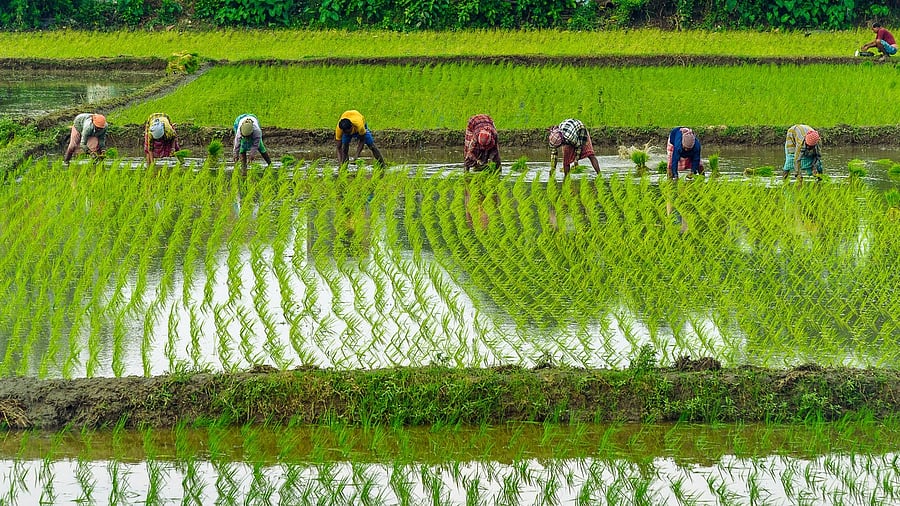
Image showing farmers in India. For representational purposes.
Credit: iStock Photo
Farmers in Punjab, under the banners of Samyukta Kisan Morcha and Kisan Mazdoor Morcha, are demanding legalisation of minimum support price for all crops, a waiver of agricultural loans, pensions for farmers and agricultural labourers, 200 days of employment per year under MGNREGA with a daily wage of Rs 700, penalties for producing fake agricultural inputs, and the protection of tribal communities’ rights over water, forests, and land, among other demands. However, MSP is not sustainable, as it would impose a huge financial burden of nearly Rs 20 lakh crore over the next five years. Instead, the government should focus on addressing fundamental agricultural issues to increase farmers’ incomes and reduce dependence on MSP.
According to the latest State of Food Security and Nutrition in the World report, around 733 million people faced hunger in 2023, equivalent to one in eleven people globally. By 2050, an estimated world population of 9.7 billion will need 14,060 trillion crop calories if the population growth follows a medium trajectory. The G20 Global Alliance Against Hunger and Poverty Task Force has found that the world is falling significantly short of achieving Sustainable Development Goal (SDG) 2: Zero Hunger by 2030. Meanwhile, IMF data shows that global food inflation reached 6.85 per cent annually in December 2024, the highest since 2014. In the face of a global food crisis, India’s 150 million farmers, cultivating 1.78 million sq km of agricultural land, with abundant water resources, diverse crops, and an expanding transportation network, have the potential to make farming a lucrative profession.
Rural life is not just about farming—it also involves eco-friendly crafts and sustainable livelihoods. Therefore, improving the quality of life in Indian villages is important. The government must prioritise quality schools, healthcare, libraries, and community playgrounds to create a more liveable environment. Additionally, reviving the healthy socio-cultural fabric of villages, once rooted in spiritualism, is essential. Rising alcohol addiction, unchecked consumerism, and idleness fuelled by free food and freebies are eroding rural work culture. There is an urgent need for awareness programmes focusing on health, environmental conservation, and the economic potential of the villages.
Indian villages can become food production hubs if their resources are preserved. Protecting water bodies, crop diversity, topsoil, native trees, and traditional handicraft skills will enhance rural economies. Farmers need access to quality inputs, timely crop insurance settlements, and efficient credit channels through self-help groups and cooperative societies. Banks should develop innovative lending models to reduce rural credit costs and risks. At the same time, the government must regulate private banks, unlicensed credit agencies, and money lenders, who charge high interest rates of 30 per cent to 65 per cent per annum. Transparent marketing facilities, de-politicisation of village institutions, and high-quality farm inputs can boost agricultural productivity.
India’s small landholdings are a hidden strength. According to the NSSO 2019 survey, 89.4 per cent of agricultural households own less than two acres of land, yet they contribute 41 per cent of India’s food grain production. These small farms can preserve the crop diversity in India’s 15 agro-climatic zones, which acts as a shock absorber against climate change. However, according to the Climate Transparency Report 2021, of the 83 per cent covered under the PM Kisan Samman Nidhi scheme, only 35 per cent have access to crop insurance, and 25 per cent receive timely financial credit, and a mere 21 per cent of marginal farmers have a cold storage within 10 km of their village—of whom only 15 per cent have ever used these facilities.
India must protect its agricultural land to capitalise on rising global food demand. Unchecked urban growth has eroded vast tracts of farmland. The Economic & Political Weekly reported in 2007 stated that in all 25 mandals surrounding Hyderabad, agriculture had ceased to be the primary activity, with over 900 sq km of farmland lost.
Similarly, Anna University researchers found that the Greater Chennai Region lost two-thirds of its farmland between 2005 and 2016. Uttarakhand’s government data reveals a loss of over 1.2 lakh hectares of agricultural land in two decades.
A comprehensive satellite study is needed to assess the nationwide loss of agricultural land, providing a factual basis for balancing economic growth with agricultural sustainability. India needs economic growth, but it must strike a balance between growth and sustainability.
(The writer is a sustainable micro- economic activities analyst)